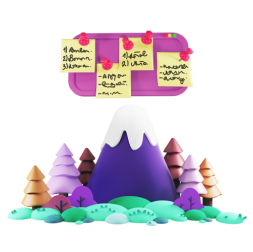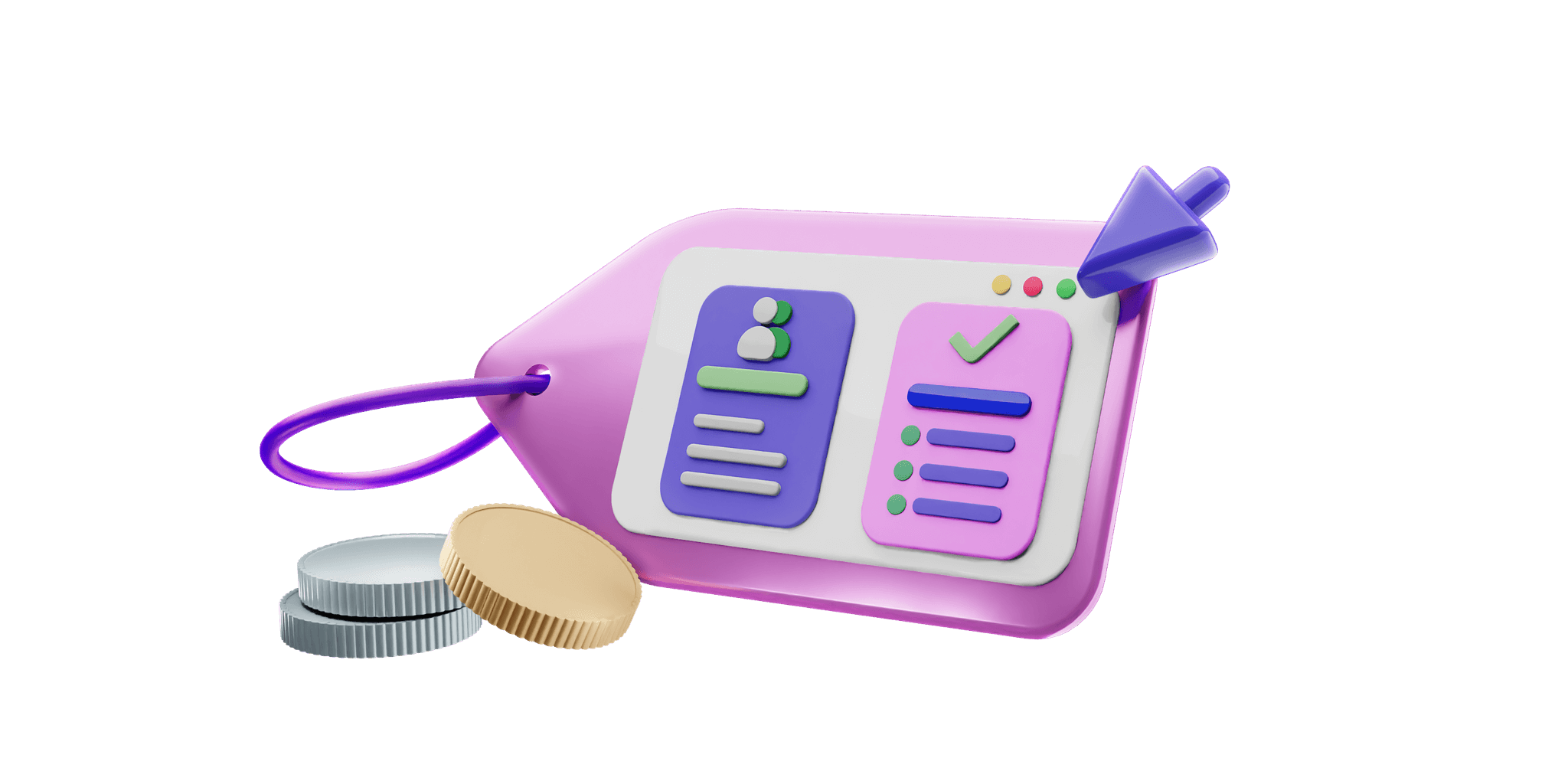Detailed guide on how to use Plaky
From creating your first task to tracking your team’s activities & progress, this guide will help you get familiar & start using Plaky so you can improve the productivity of your work.
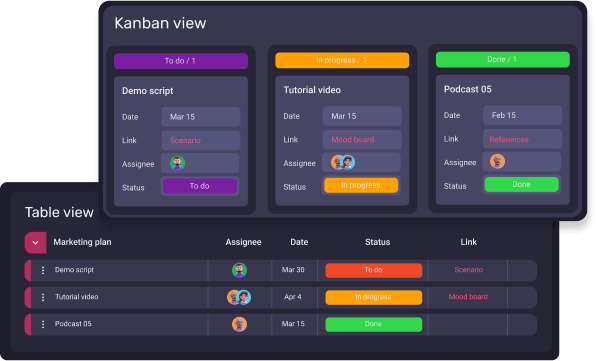
Table of Contents
What is Plaky?
Plaky is a flexible and highly customizable project management tool that helps teams from all industries plan projects & stay on top of their tasks.
Work becomes transparent as you track progress and see what everyone on your team is working on. You don’t have to worry about missing anything important, as you will get in-app and email notifications when any change occurs.
Now let’s dive deeper and see how you can kick-start your project faster & be more efficient.
Boards
So everything starts with a board. In Plaky, board is a project-dedicated space where you can plan and organise anything. Board is a visual representation of your team’s tasks, workflows and processes.
To create a board you have two options.
- First Navigate to the Space menu
- Choose New Board
- And Now choose either Create from scratch or Create from template
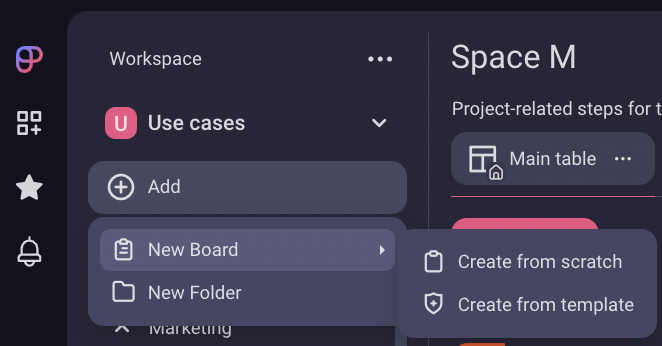
If creating from scratch:
- Enter Board name
For the purposes of this guide, we’ll set an example based on a case of a marketing agency called Futura that organises all of its work in Plaky. We’ve created a board called Space M for the rebranding campaign of their client.
2. Click Create Board to complete the action
If you think this workflow it’s not applicable for your type of work, don’t worry, Plaky can adjust to your needs because it’s highly flexible & customisable, so you can organise everything, from complex projects, to simple tasks, events, clients and much more.
For everybody in the team to know what the board is about, simply add a description.

You always have the possibility to avoid starting projects from scratch. Instead, you can choose one of our pre-made templates, created to suit many different industry, businesses, and teams.
Templates help you to kick-off your project faster.
Simply click on “choose template”. You can always change it later on.
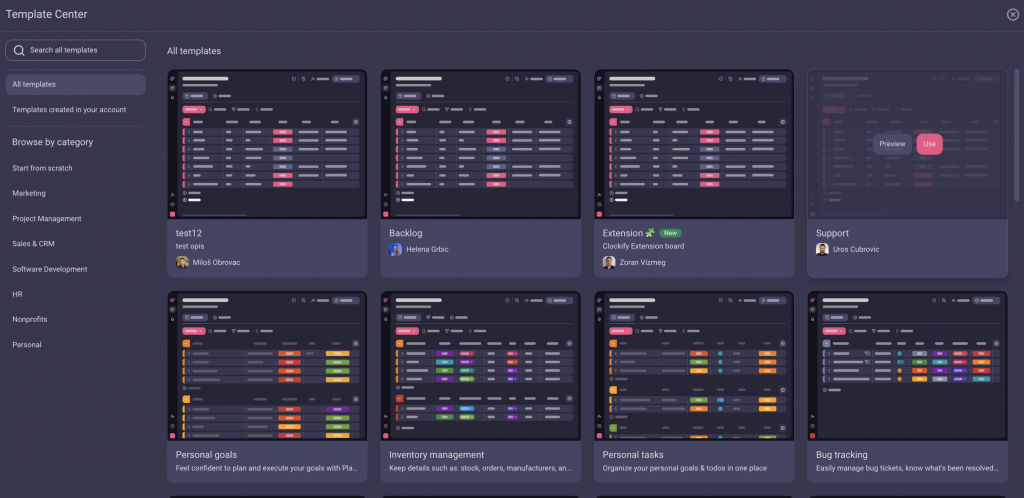
Types of boards
You can change the board type for privacy reasons. You can set it to be either public – open to anyone from your team so they see anything, and private – available to only certain members.
You see that the newly-created board consists of rows and fields. Rows represent individual tasks and fields represent different stages of the project or different categories of tasks.
In order to organise your board you should know how it can be configured and adjusted using these main components in Plaky.
Groups
Tasks are organised in groups.
A group is a section on your board that contains your tasks and represents a timeframe (quarters or months), a project phase, a stage or any other way you decide to organise your future tasks. You can color code the groups so it’s easy to visually access the information on your board.
- Hover over the “new item” section on your board.
- Click on the down-facing arrow appearing on the left side and
- Choose “New group of items”.
Tasks
We now switch to items in order to create tasks. It’s where all the action is. They are the fundamental building blocks of your project and can be anything, from tasks to clients, employees, equipment and much more.
- Click on the “+” button in the column where you want to add the task.
- Enter the task title in the text field.
Just keep in mind to create specific task names that are action-oriented, and clearly define the item.
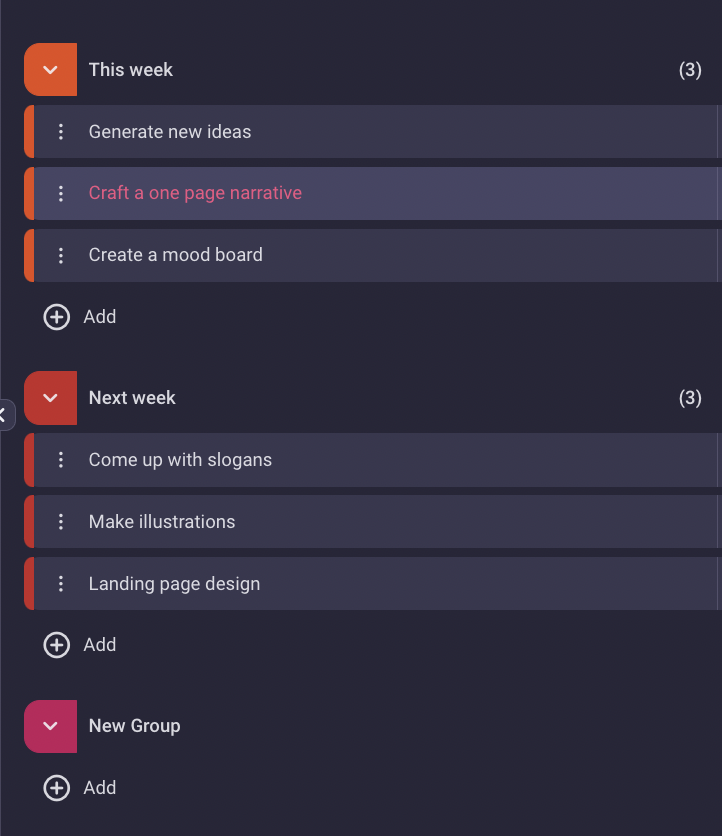
Fields
You can further categorise your tasks by specific information related to your project. We have 8 different field types that are most commonly used for any type of project and we find them to be essential for a good board organisation in Plaky.
Add a relevant field that matches the data you want to be shown on your board.
For example, here we have a person field so the team knows who is responsible and for what. We can include one or more members from our organisation or we can even add a whole team. They will be instantly notified by bell or email that they were assigned to this specific task.
Additionally, we feel like we want to explain the task a bit more in order to make it transparent and easily understandable to all board members. So we’ll add a rich text field and name it a “Description”. Here you can add links, make check-lists or highlight important parts of what you need to emphasise.
Furthermore, we will add a status field, which is super useful because it has its own customisable labels that can let your team indicate if a task is to do, in progress or done, so you can understand what needs your attention just by looking at the color-coded status bar.
You can even have multiple status fields, indicating other things such as priority, which is extremely useful when creating views. We talk about views later on.
Next, we’ll add a date field with due dates for the tasks we need to complete. Date field can also indicate a date of launch, an initiation date or a date when a task has been executed and many other time-related information.
If we need to place numeric data for some of the information related to our task we will add a number field. In this case it will indicate a budget for some of the marketing activities.
We want to add one more field to complete the process of categorisation of data on our board.… Here we are going to add another status field, but it will now specify the priority of the tasks. High, medium and low priority.
Now that we’ve put all the relevant information, let’s see how they can be shown for the most effective overview of tasks.

Board views
Board views are the best way to visualise the data on your board and see your project from a different perspective.
For example, you can click add view, choose Kanban, and see all items grouped by status.
If you click settings, you can choose to hide some item information, turn off dividing by group, or even group items by some other status field.
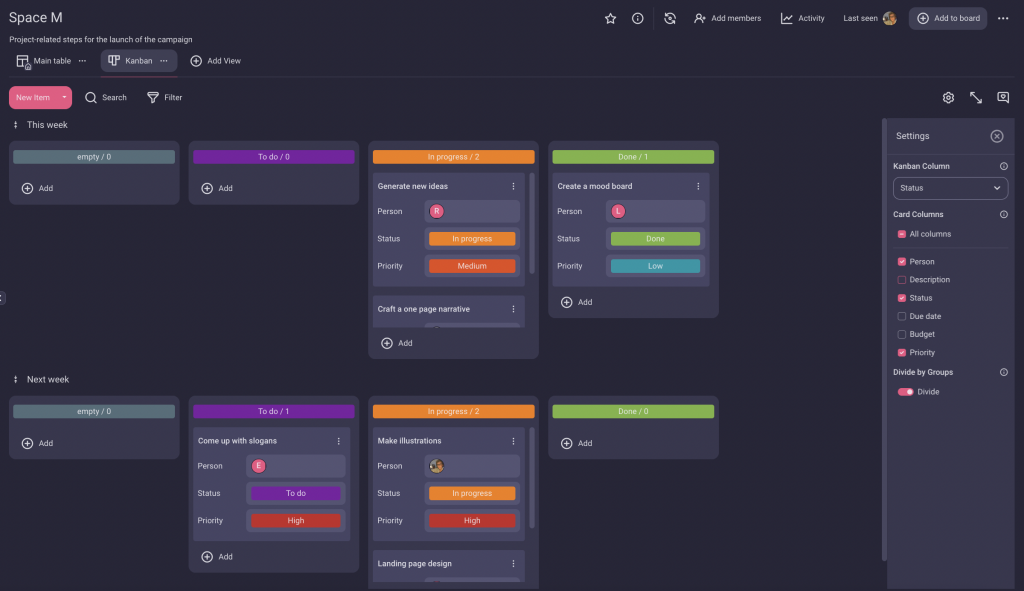
Next, you can sort items by values in some field, and filter the board by some field, like person for example.
When you leave and come back, all the configuration in the view will be saved.
You additionally have the Gantt chart view where project timelines are visually displayed, offering a clear overview of tasks and their progress.
In the Gantt view, tasks are depicted as horizontal bars on a timeline, providing clarity on task durations and the project schedule. You can customize Gantt fields, grouping, coloring, and labeling criteria, as well as adjust additional view settings in the Gantt view Settings.
Views are also super useful because each team can set its own view by the data they find interesting.
Board organisation
If we go back to the main table of the board we can look at some ways in which we can organise it. If you need to move tasks from one group into another, you can do that just by dragging & dropping them where you think they should belong.
We can move other things on our board such as fields…. Or even groups, again by dragging & dropping.
For more efficient organisation, you can duplicate your board, your item or a specific column with or without its values.
Folders
Organise your boards by placing them in appropriate folders, so you and your team can have an organised view of all projects in your workspace. You can click to collapse and expand your folder for a better overview.
You can click on the star in the panel on the left side to favor a board or few of them that you visit most often. Your favorite boards can be found and easily accessed from there.
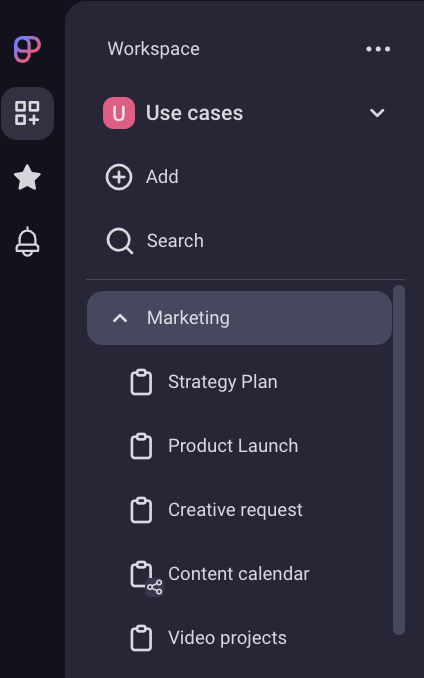
Spaces
When we mentioned spaces, let’s see how we can organise them too. With spaces, you can manage different sections dedicated to multiple departments, teams, projects, tasks and all related correspondence with your coworkers in one place.
Before we say a few words about correspondence & collaboration with teammates, let’s see how you can include all the relevant people to a project.
User roles
Plaky offers a range of different user roles and access permissions that help you and your coworkers have a better control of your workspace, overview of each-others tasks and work status enabling you to fully enjoy all the features and functionalities.
Based on the access level, user roles are as follows:
- Admin
- Member
- Viewer
Let’s say you are an admin and you’ve created the organisation. You’ll have all permissions available on your account. You can modify and configure the space, one or more, modify, configure and change boards and tasks, control access permissions for other users and transfer ownership to team members.
You as a board owner can do everything, while board members can either:
- Edit everything
- Edit content
- Write updates only
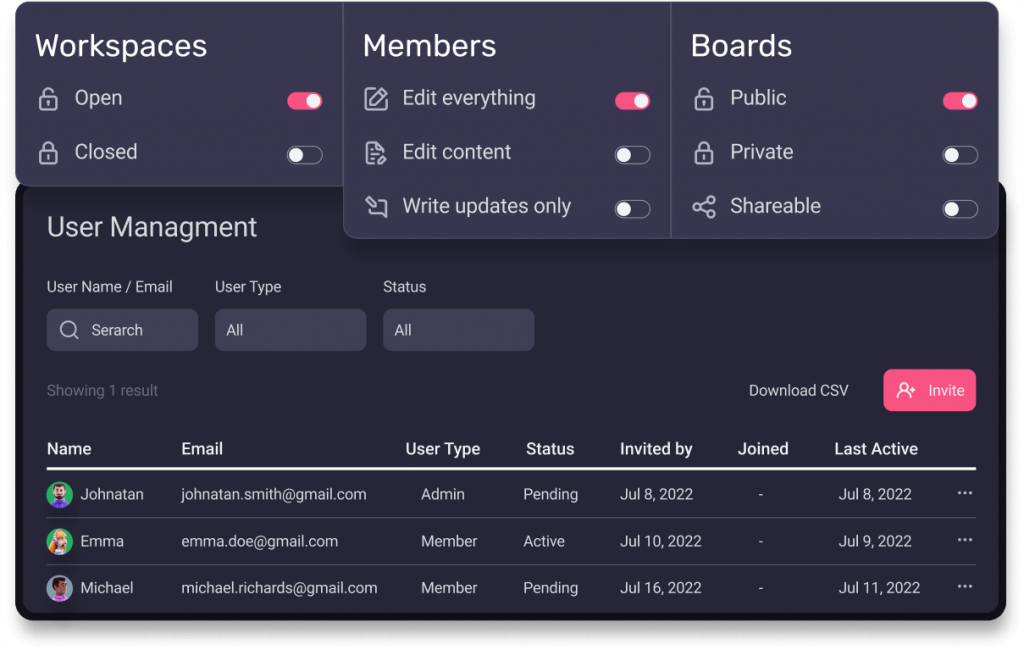
You can invite members with their email address. You can then organise all members into teams. it’s much easier from an administration perspective to have them grouped into departments or teams. You can later on add a member from a team or a whole team by simply including the name in the bar.
Collaboration & communication
When you have your members on board, it is easier than ever to collaborate – and Plaky is all about good planning, organisation and collaboration.
It’s all very transparent & everybody can stay in the context since everything happens in the item card.
The speech bubble icon indicates that you have messages as part of your tasks. The number specifies how many messages there are in total. You can see them all by clicking on the item. Go to the comment section and access the communication history related to that specific task. Check prior updates or write new messages so you and your teammates can easily stay on top of the situation.

When you see that someone from your team is working on a task where you can offer your help, mention them by using the @ button so they’ll instantly be notified by the bell icon on the left, which will lead them directly to the message. This way we speed up the communication process.

Notifications
Notifications help us stay informed at any time about updates & changes.
The bell is where you receive all of the information that’s specifically relevant to you. You won’t miss on anything important concerning projects you’re involved in.
Beside bell Plaky also offers email notifications.
You’ll get both when:
- You’re subscribed to a Board
- Someone assigns you to an Item
- mentions you in a comment or reply and many more…
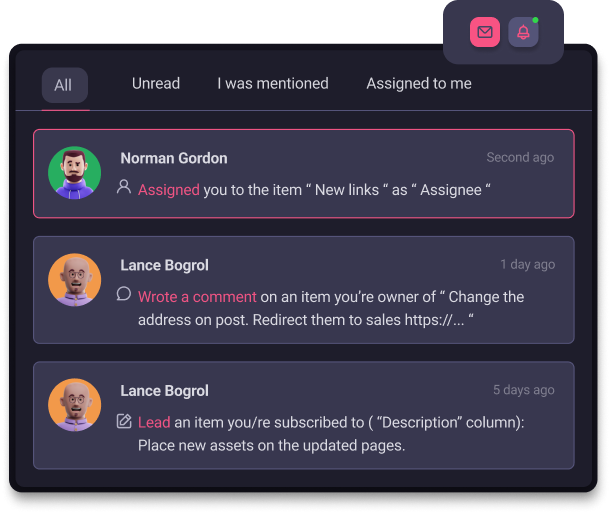
By clicking on the link in your email, you’ll jump to the relevant section in Plaky where the action you were notified of occurred.
You can decide to make changes to your notification preferences and select which notification you actually want to receive and where. You can do that in the profile settings in the panel on the left side.
Activity log
As teams start to grow and take on extra work, visibility into the tasks done and changes made can seem a bit muddied & difficult to track. Plaky can solve this problem for you with the Activity log feature.
There are several types of activity logs available in Plaky:
- Board Activity Log
- Item Activity Log, and
- Last Seen
They display all past activities, from status change or update, added Comments, deleted Items or assigned Team Members to Boards…. Which team members were active and how long ago.
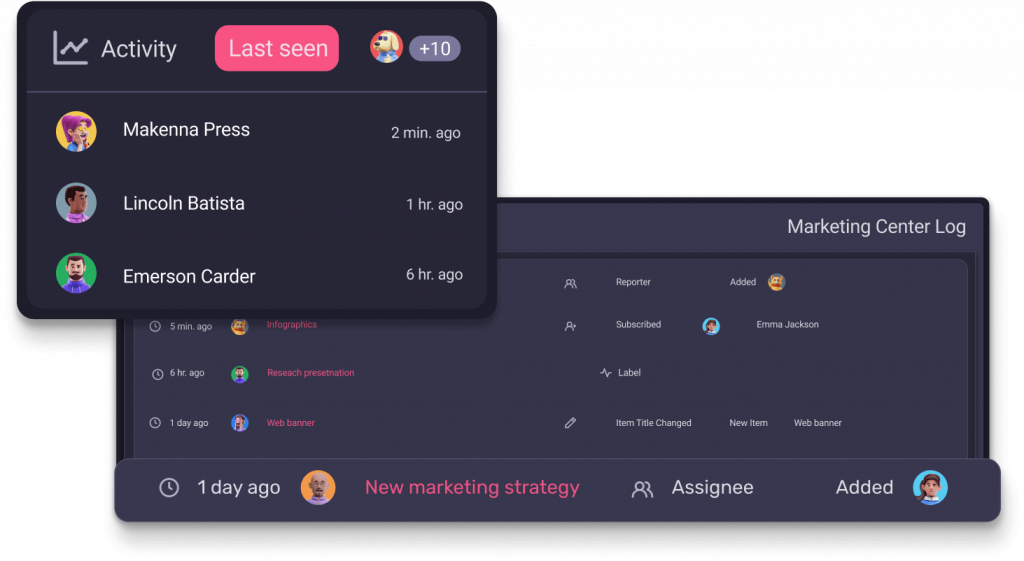
Conclusion
Before we wrap up I would recommend visiting our Knowledge hub, Blog, Help center to find all the answers you might have related to Plaky and project management in general.
Feel free to use our resources while using our tool for better and more flexible organisation of your work.
 Plaky Resources
Plaky Resources 


